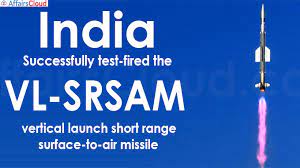The vertical launch surface to air missile.
- India successfully flight tested the Vertical Launch Short Range Surface to Air Missile (VL-SRSAM) intended for Indian Naval warships earlier this week for the second time since February of this year.
- The VL-SRSAM was conceived and designed in-house by the DRDO for the Indian Navy.
- The missile system is designed to counter a variety of airborne threats at close ranges, including sea-skimming targets.
What is VL-SRSAM
- For deployment of Indian Naval vessels, the VL-SRSAM was planned and developed collaboratively by three facilities of the Defence Research and Development Organisation.
- Facilities of DRDO: Defence Research and Development Laboratory (DRDL) and Research Centre Imarat (RCI), both from Hyderabad, and Research & Development Establishment (Engineers) based in Pune
- The missile is capable of neutralising a variety of aircraft threats, including sea-skimming targets, at close range.
- Various anti-ship missiles and fighter planes employ the technique of sea skimming to avoid being identified by battleship radars.
- As a result, these assets fly as near to the water surface as possible, making them difficult to identify and neutralise.
Features of VL-SRSAM
- The cruciform wings: Four tiny wings that form a cross on four sides and provide a stable aerodynamic stance for the projective.
- Thrust vectoring: The ability to adjust the angular velocity and attitude of the missile by changing the direction of the push from its engine.
- The VL-SRSAM is a canisterised system, which means it is stored and operated in dedicated compartments.
- The inner atmosphere of the canister is regulated, making transportation and storage easier and increasing weapon shelf life.
Significance of Testing
- The launch was carried out from a vertical launcher at a very low altitude against an electronic target.
- A variety of tracking equipment installed by ITR, Chandipur, were used to follow the vehicle's flight route as well as its health data. All of the sub-systems operated as expected.
- The system was launched to ensure that all weapon system components, including the vertical launcher unit with controller, canisterized flying vehicle, and weapon control system, worked together.
- The successful testing of these systems was critical for future missile launches from Indian naval vessels.


